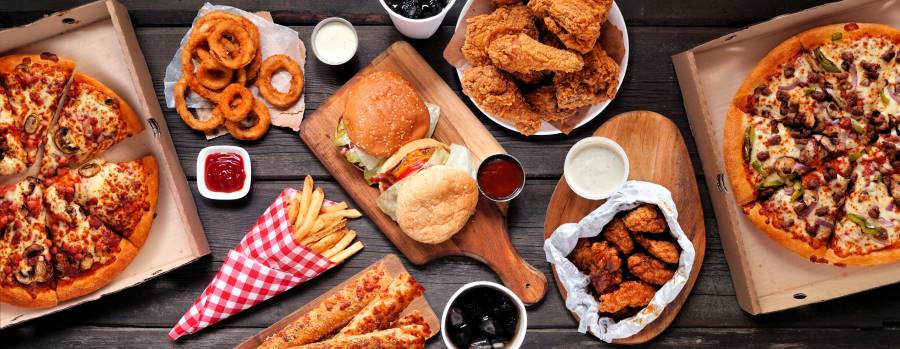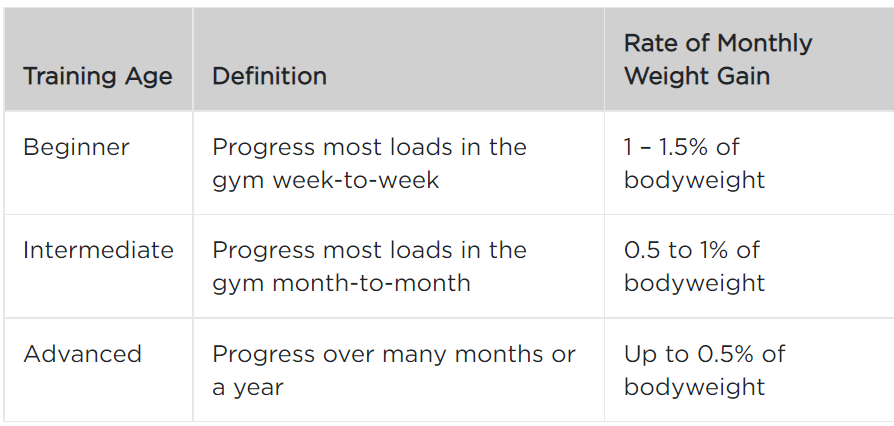How do you gain muscle effectively? This is the million-dollar question for many men who struggle to build that coveted ‘cover model’ physique.
You might have heard that you need to ‘eat big to get big’ – the classic ‘dirty bulk’.
But science and common sense show us that this is not the best approach to gaining muscle in a healthy and methodical way.
Muscle growth doesn’t need to be complicated. And you don’t need to sacrifice your health and your sanity to achieve it with ‘dirty bulking’, ‘clean bulking’ or anything other than sound nutritional principles and progressive training.
We look at what a ‘dirty bulk’ is, why it’s bad for your health, how many calories you really need to build muscle and how to maximise your training to gain size with actionable tools and tips.

Ultimate Performance client Ethan gained 6kg of lean body mass over 45 weeks.
Origins of the ‘dirty bulk’ myth
The origins of the dirty bulk lie in the bodybuilding circles of the 70s and 80s, which popularised the concept that excessive calorie intake was crucial for muscle growth.
Calorie-dense, hyper-palatable foods became a dietary staple due to trainees’ incredibly high-calorie requirements because it was almost impossible to hit these targets purely consuming unprocessed, nutrient-dense foods alone.
The traditional ‘bulk-cut’ methodology is also strongly premised on the routine use of anabolic steroids and cutting agents in such spheres.
Bodybuilding is an elite sport, and to compete at the highest levels, athletes often use large amounts of performance-enhancing drugs (PEDs).
When using such quantities of drugs, you will grow muscle regardless of the quality of foods you are consuming. And when it comes to cutting after a ‘bulk’, PEDs also allow you to cut hard and fast while minimising muscle loss.

Is ‘bulking’ necessary?
‘Bulking’ refers to increasing calorie intake beyond maintenance energy requirements to support a muscle-gain phase. The concept relies on the 3,500-calorie rule; if a 500-calorie deficit results in one pound of fat loss per week, a 500-calorie surplus should create one pound of muscle growth.
But the science behind muscle gain is far more nuanced. For example, if you dissect a pound (0.5kg) of hydrated muscle, you’ll find that it is only around a third protein, with the rest being minerals and water. As a result, a pound of muscle only contains roughly 800 kCal (compared to 500 kCal in 1lb of fat) [2]. This shows that muscle mass is far more metabolically costly to synthesise and maintain than body fat, which requires little additional output.
If you are not overweight and not new to resistance training, gaining weight nearly always involves gaining a little bit of fat as well as muscle [3]. Furthermore, because building and maintaining muscle involves increased caloric expenditure, you may need to increase your calories more than expected [4]. Of course, the bigger and faster you go with your bulk, the more calories you need, increasing the risk of significant fat gain. In addition, a ‘dirty bulk’ involves eating high amounts of processed, calorie-dense foods with little thought for the potential health costs.

Science does not support massive calorie surpluses
The research shows that eating at or just over maintenance calorie intake is more than sufficient to gain muscle. A 2013 study of resistance-trained athletes found that the group who consumed a small surplus gained roughly the same amount of muscle and strength as the group who consumed an extra 600 calories but gained an extra 20% body fat [5].
Rates of muscle gain vary significantly based on your ‘training age’: the amount of time you have performed a particular sport, such as resistance training. The term refers to the cumulative skill level developed over weeks, months or years of training and reflects your training history and potential for continued improvement. The table below indicates what you can expect to gain per month, based on your training age [6]:

The downsides of dirty bulking
Beyond being unnecessary for the average trainee, eating excessively beyond your energy requirements also has several downsides.
1. You’ll probably lose your ‘gains’
Muscle gain from a big calorie surplus means gaining more body fat too. The bigger the surplus, the greater the fat gain is likely to be. And the more fat you have, the more aggressively you need to diet during the subsequent cut, losing hard-earned additional muscle in the process.
2. Dirty bulks should come with a health warning
Significant fat gain also involves various detrimental health effects, including reduced insulin sensitivity, increased visceral fat, and lower testosterone. And that’s not to mention the increased risk of high blood pressure, cardiovascular disease, and high cholesterol.
3. Buying, preparing and eating food costs time, money and energy
Unless you’re happy to carry around a cooler bag with 10 meals a day, a dirty bulk isn’t practical for most people. Eating a ton of food costs a lot more and requires time to buy, prepare, and eat it.
4. Gym performance may improve but your mental performance could suffer
While lots of additional calories will help fuel your workouts, you may find yourself feeling sluggish and struggling to stay awake throughout the day. If you’re chasing that next promotion at work, there could be other means to achieve your goal without sacrificing your mental sharpness and ‘real’ energy levels.
5. You’re likely to spend a lot of time feeling nauseous
Even the most palatable foods become unappetising in excess. Depending on your initial body composition and daily activity levels, eating vast amounts of calories from high-quality foods is difficult. The alternative is low-quality foods that increase your risk of serious negative health outcomes.

Our approach with clients at Ultimate Performance is to get lean and insulin-sensitive before starting a phase of muscle building. See how Kamran built muscle in 26 weeks here.
So, what’s the answer to maximising your gains?
If you want a cover-model physique, these five priorities are far more effective than a dirty bulk for most trainees.
1. Focus on fat loss before muscle gain
A fat loss approach will do far more to boost your credentials on the beach than a dirty bulk that leaves you inflamed, sluggish and self-conscious. Improving your body composition accentuates your muscle definition, creating the illusion of looking bigger. For most men, dieting to around 8-10% body fat puts you in a good position to gain muscle, and even if you do gain some fat, you’ll still be in relatively good shape.
2. Train smarter
How many guys do you know that train ‘bro splits’ or follow the latest program by an Instagram influencer? These approaches rarely allow you to consistently maximise training volumes and often include fixed ideals of the ‘best’ exercises that don’t fit your unique anatomy. Whether your goal is fat loss or muscle gain, smart program design and exercise execution is a must.
3. Train harder (but more consistently)
Training intensity is a measure of how hard you are working, and while you might think you’re giving it your all, you could be missing a trick if you’re not tracking it. The research shows that the final five repetitions before true muscular failure trigger the most growth [7], [8].
The ‘reps in reserve’ system accounts for inevitable fluctuations in strength and energy levels. As a general rule, aim to hit around two to three reps in reserve before absolute muscular failure in your initial sets.
On the final set, in exercises where you’re stable, secure, and there is minimal injury risk, e.g., a chest fly or biceps curl, push for all-out failure. In high-risk, technical exercises, such as squats or deadlifts, stopping shy of failure prevents injury, performance decreases and impaired muscle growth [9].

4. Give your body the building blocks to grow by maximising nutrient intake
If you put crap in, you get crap out. How can you expect your body to perform at its best if you don’t properly meet its nutritional needs? While there is scope for more dietary flexibility in a muscle-gain phase, you should still aim to obtain the majority of your intake from single-ingredient, high-quality sources. Not only will you remain metabolically healthy, but it will prime you for gaining lean muscle rather than a ton of body fat. When it comes to setting your calorie goal, it’s usually a case of trial and error. Work from your maintenance calorie intake using an online calculator and adjust based on progress.
5. Manage sleep and stress
Research demonstrates that sleep impacts muscle protein synthesis, the driving force behind adaptive responses to exercise. Sleep loss of just two hours can double the rate of muscle loss [10]. Studies also consistently link chronic stress to low testosterone, impaired gym performance, and muscle loss [11], [12], [13]. So, if you’re serious about maximising your gym results, invest in improving your sleep hygiene and managing stress.

How Stewart build muscle the right way
When 51-year-old Stewart first came to Ultimate Performance, he says he was ‘skinny’ fat and his diet was poor. He smoked 30-plus cigarettes a day and would regularly drink wine.
Initially, Stewart went through a 15-week phase of fat loss to lose around 5-6kg of fat and focused on a nutrient-rich diet while quitting smoking and drinking to excess too.
This put him in a great position – being lean and insulin-sensitive meant he was primed to build muscle effectively.
Having a low body fat meant it was easier to increase his calorie intake incrementally while being able to monitor his body fat levels.
Over 20 months, Stewart was consistent with his training and followed the core principles of predominantly ‘eating from the land’ and exercising sensible portion control.
He was steadily and methodically able to gain muscle size and strength during this period. Now he’s in his early 50s and lean, well-muscled and strong without having to compromise his health with a ‘dirty bulk’.

Read more about the 7 tips that helped Stewart achieve his long-term muscle building transformation.
Summary
Unless you’re planning on stepping on the Mr Olympia stage anytime soon, a dirty bulk simply isn’t necessary. Eating at maintenance calorie intake or a moderate surplus is more than sufficient to stimulate muscle growth. If muscle gain is your focus, getting lean should come first. And when you are ready to grow, make sure you prioritise high-quality foods, intelligent program design and execution and effective recovery.
Key Takeaways
- A ‘dirty bulk’ refers to eating in a large calorie surplus to boost muscle growth, often via excessive intake of processed, calorie-dense foods.
- Most ‘bulking’ approaches assume that if it takes a daily 500-calorie deficit to lose a pound of fat per week, you require a 500-calorie surplus to gain a pound of muscle.
- Bodybuilding circles of the 70s and 80s popularised the myth, emphasising eating as much as possible during a growth phase.
- For the average trainee, dirty bulking increases the likelihood of significant fat gain, which may have serious implications for metabolic health.
- Muscle gained through a ‘dirty bulk’ will likely disappear during the subsequent hard dieting required to achieve a healthy body composition.
- For most male trainees, getting leaner will do far more for your physique and set you up for a successful muscle growth phase.
- Smart program design, nutrition and recovery are a much safer investment when it comes to increasing your gym gains.
Want more actionable advice for gaining size? Read our 100 Greatest Muscle Building Tips article.



